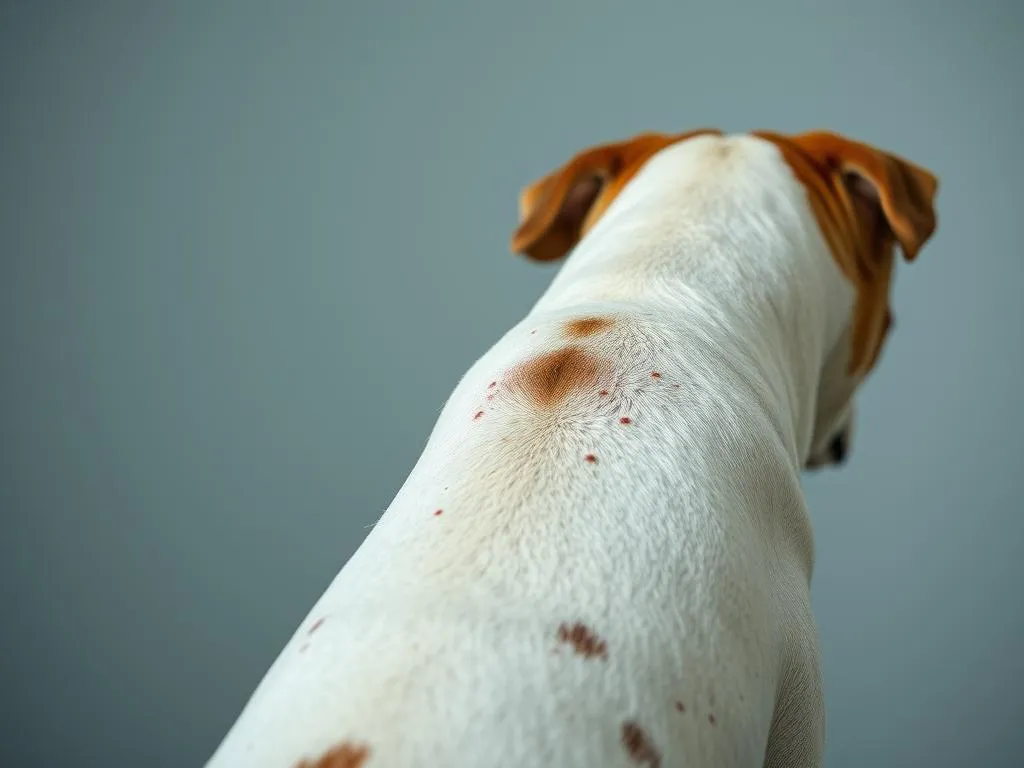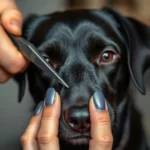
Introduction
Caring for our canine companions involves more than just feeding and walking them; it encompasses a thorough understanding of their health and well-being. One common concern among dog owners is the appearance of scabs on their dog’s back. These skin issues can be indicative of various underlying conditions that could affect your dog’s overall health. By addressing these skin concerns promptly, you can ensure your dog remains happy and healthy.
In this article, we will delve into the intricacies of canine skin health, explore the potential causes of scabs on your dog’s back, and discuss how to identify and treat these conditions effectively. We will also cover preventive measures and when to seek professional help. Let’s embark on this journey to better understand our furry friends’ health!
Understanding Canine Skin Health
Importance of Healthy Skin
The skin serves as the largest organ in a dog’s body, acting as a protective barrier against environmental hazards, pathogens, and allergens. Healthy skin not only protects against infections but also plays a crucial role in regulating body temperature and hydration. A dog’s skin health often reflects its overall health; issues such as dryness, flakiness, or the formation of scabs on their back can be warning signs of underlying health problems.
Common Skin Issues in Dogs
Skin conditions are among the most frequently reported health issues in dogs. Studies indicate that approximately 10-15% of dogs will experience some form of skin ailment during their lifetime. Common skin problems include allergies, infections, and infestations by parasites, all of which can lead to uncomfortable symptoms and, if left untreated, serious health complications.
Possible Causes of Scabs on a Dog’s Back
Allergies
One of the primary reasons for scabs on a dog’s back is allergies. Dogs can suffer from various types of allergies:
- Food Allergies: Certain ingredients in dog food can trigger allergic reactions.
- Environmental Allergies: Pollens, dust mites, and mold can provoke skin reactions.
- Contact Allergies: Exposure to certain materials, like plastics or certain types of grass, can lead to dermatitis.
Symptoms of allergic reactions can include excessive scratching, licking, and the development of scabs. It’s crucial to identify the source of the allergy to alleviate your dog’s discomfort effectively.
Parasites
Parasites are another common culprit for skin issues, particularly fleas, ticks, and mites.
- Fleas: These small insects can cause severe itching and irritation, leading to scabs from scratching.
- Ticks: Besides causing irritation, ticks can transmit diseases that may affect your dog’s overall health.
- Mites: Conditions such as mange are caused by mites and can lead to hair loss and scabs.
Identifying a parasite infestation typically involves looking for signs like increased scratching, hair loss, and the presence of fleas or ticks in the fur.
Infections
Bacterial and fungal infections are significant causes of scabs on a dog’s back.
- Bacterial Infections: These can arise from broken skin due to scratching or biting, leading to more severe issues if untreated.
- Fungal Infections: Conditions like ringworm can cause scabs, hair loss, and redness.
Signs of skin infections may include redness, swelling, and a foul odor. Prompt veterinary attention is crucial to treat these infections effectively.
Injuries and Trauma
Another common cause of scabs on a dog’s back is injuries or trauma. Dogs can sustain cuts, scrapes, or wounds during play or by getting caught on objects.
- Common scenarios include rough play with other dogs, running through thick brush, or even scratching against furniture.
- It’s essential to monitor your dog’s behavior to determine if they are excessively licking or scratching a specific area, which could indicate irritation or pain from an injury.
Other Medical Conditions
In some cases, scabs on a dog’s back may be a symptom of more serious medical conditions:
- Autoimmune Disorders: Conditions like pemphigus can cause skin lesions and scabs.
- Hormonal Imbalances: Issues such as hypothyroidism can lead to skin problems.
- Skin Tumors: While less common, tumors can also manifest as unusual growths or scabs.
Being aware of these potential conditions can help you seek timely veterinary assistance.
Identifying the Cause of Scabs
Observational Techniques
When you notice scabs on your dog’s back, observing your dog’s behavior and physical symptoms is essential. Pay attention to:
- Size and Color: Are the scabs small or large? Are they red, brown, or black?
- Location: Are they isolated to one area or widespread?
- Behavior Changes: Is your dog scratching more than usual, or showing signs of discomfort?
These observations can provide valuable information to your veterinarian.
When to Consult a Veterinarian
While some skin issues may appear benign, certain signs warrant immediate veterinary attention:
- Persistent Scratching or Biting: If your dog cannot stop scratching, it may lead to more severe injuries.
- Swelling or Redness: Significant inflammation can indicate a more serious problem.
- Change in Appetite or Behavior: If your dog shows lethargy or refuses to eat, this could signal an underlying condition.
Regular check-ups and proactive skin assessments are crucial in maintaining your dog’s health.
Diagnosis and Treatment Options
Diagnostic Procedures
When you consult a veterinarian about scabs on your dog’s back, expect them to conduct a thorough examination. Common diagnostic procedures include:
- Skin Scrapings: This test helps identify parasites or fungal infections.
- Allergy Testing: If allergies are suspected, your vet may recommend skin or blood tests to determine specific triggers.
Accurate diagnosis is vital for effective treatment, so providing your veterinarian with detailed observations about your dog’s skin condition is beneficial.
Treatment Approaches
Once the cause of the scabs is identified, your vet will recommend appropriate treatments, which may include:
- Medications: Antihistamines for allergies, antibiotics for bacterial infections, or antifungals for fungal infections are common prescriptions.
- Dietary Changes: Switching to a hypoallergenic diet or adding supplements like omega-3 fatty acids can support skin health.
- Topical Treatments: Medicated shampoos or ointments can help soothe irritated skin and promote healing.
Home Remedies and Care
For minor skin issues, some home remedies can be beneficial:
- Oatmeal Baths: These can soothe irritated skin and reduce itching.
- Coconut Oil: Applying coconut oil can help moisturize dry skin and promote healing.
Maintaining a clean environment is also essential. Regularly washing your dog’s bedding and keeping their living space free of allergens can significantly improve their skin health.
Preventive Measures
Regular Grooming
Regular grooming is crucial for maintaining healthy skin.
- Brushing: Helps remove dead hair and skin, preventing matting and skin irritation.
- Bathing: Use dog-specific shampoos that are gentle on the skin to prevent dryness.
Investing in quality grooming products tailored to your dog’s skin type can enhance their skin health.
Nutrition and Diet
A balanced diet plays a significant role in your dog’s skin health.
- High-Quality Dog Foods: Opt for foods rich in essential fatty acids and vitamins.
- Supplements: Consider omega-3 fatty acids or probiotics to support skin health and immune function.
Consult your veterinarian for dietary recommendations that suit your dog’s specific needs.
Environment Management
To reduce allergens in your home:
- Regular Cleaning: Vacuum frequently to reduce dust and pet dander.
- Parasite Prevention: Use vet-recommended flea and tick preventatives to keep parasites at bay.
Taking these steps can significantly reduce the risk of skin problems.
When to Seek Professional Help
Signs of Serious Conditions
It’s essential to recognize indicators that may suggest a more severe underlying issue:
- Rapidly Spreading Lesions: Scabs that are increasing in number or size can indicate an infection.
- Severe Itching: If your dog is excessively scratching or biting, it’s time to consult a vet.
Understanding these signs can help you act quickly and ensure your dog receives the care they need.
Building a Relationship with Your Veterinarian
Finding the right veterinarian is crucial for your dog’s health.
- Research: Look for a vet who understands your dog’s specific breed and health issues.
- Open Communication: Regular health checks and discussions about skin conditions can help maintain your dog’s well-being.
Establishing a strong relationship with your veterinarian ensures you have a trusted partner in your dog’s health care journey.
Conclusion
Addressing scabs on your dog’s back is not just about treating the visible symptoms; it’s about understanding what lies beneath. By prioritizing your dog’s skin health, you help ensure their overall well-being. If you notice any concerning symptoms, don’t hesitate to contact your veterinarian. Your dog’s health and happiness depend on your vigilance and care.
By taking proactive steps in understanding and managing your dog’s health, you can ensure they lead a comfortable, fulfilling life.
FAQ Section
Why does my dog have scabs on their back?
Scabs can be caused by various issues, including allergies, infections, parasites, or injuries. Observing your dog’s behavior and symptoms can help identify the cause.
When should I take my dog to the vet for scabs?
If the scabs are persistent, spreading, or accompanied by other symptoms like swelling or changes in behavior, it’s time to consult your veterinarian.
What are some home remedies for minor skin issues?
Oatmeal baths and coconut oil can soothe irritations. However, consult your vet before trying any home remedy.
Can diet affect my dog’s skin health?
Yes, a balanced diet rich in essential fatty acids and vitamins can significantly improve skin health.
How can I prevent skin issues in my dog?
Regular grooming, maintaining a clean environment, and proper nutrition can help prevent skin problems. Regular vet check-ups are also crucial.









